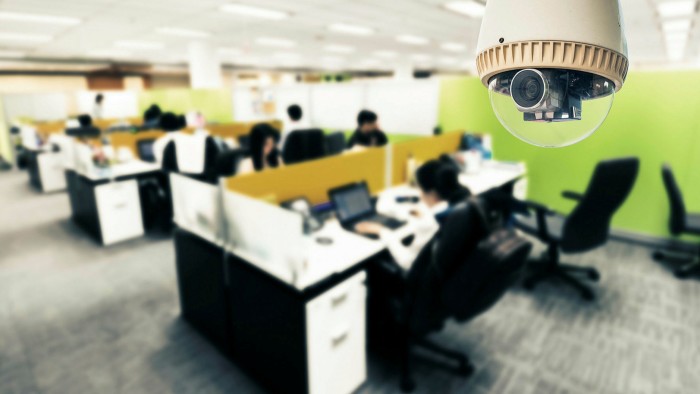Workplace surveillance may hurt us more than it helps


Roula Khalaf, Editor of the FT, selects her favourite stories in this weekly newsletter.
You can’t fault Amazon’s timing. In the middle of a global pandemic, the online retailer has launched a new workplace surveillance tool that could help to slow Covid’s spread. Called AWS Panorama, it uses computer vision technology to analyse footage from security cameras in workplaces. It can detect when employees are not complying with social distancing rules, for example.
Amazon, which plans to sell the tool to other employers, says it can improve workplace safety in other ways, too. “Are people walking in spaces where they shouldn’t be? Is there an oil spill? Are they not wearing hard hats? These are real-world problems,” a senior executive told the FT.
It’s easy to see how the technology could help in the fight against Covid-19, since workplaces are a major source of transmission. It could reveal pinch points in factories where social distancing isn’t possible, for instance, which might prompt companies to redesign work processes. But, like any tool, the outcomes will depend on the people who wield it.
Having read a lot of corporate safety incident reports over the years, I’m struck by how often CCTV footage is used to blame the worker who was hurt. In a recent example from a British meat factory (an industry where work pressures are often intense), a man fractured his hand when running to fetch a metal plate. “This is a behavioural safety issue [because he shouldn’t have run] and he will be disciplined upon his return,” the company wrote in the report to the UK’s health and safety regulator. There was no mention of why he felt the need to run in the first place.
In this context, it’s not hard to imagine a future scenario where workers are blamed for contracting Covid-19, possibly with implications for their sick pay, by employers unwilling to consider their own role and responsibilities.
There is also the possibility of mission creep. A testimonial on the AWS Panorama website from guitar-maker Fender enthused: “We can track how long it takes for an associate to complete each task in the assembly of a guitar so that we’re able to optimise efficiency and track key metrics.” The comment has now been deleted from the site.
Many employers are exploring how to use technological surveillance to drive productivity and measure performance. In 2018, the research company Gartner surveyed 239 big companies and found more than half were using non-traditional monitoring techniques, up from 30 per cent in 2015. Gartner defines monitoring as things such as “analysing the text of emails and social-media messages, scrutinising who’s meeting with whom, gathering biometric data and understanding how employees are utilising their workspace”.
Walmart, the US retailer, has filed a patent for a system of sound sensors placed near cashiers which could “determine a performance metric for the employee based on the audio data”. In the white-collar world, an array of companies are selling software that enables employers to monitor what workers do on their computers. Time Doctor, for instance, will take regular screenshots of each employee’s screen, measure their breaks and send nudges if they stray on to non-work related sites. Supervisors are given dashboards that show “who’s a superstar and who’s slacking off”.
But you don’t have to be a slacker to recoil at the idea of constant monitoring. Humans are hard-wired to feel uncomfortable being watched all the time, especially when under pressure to meet stretching targets. “It makes me afraid, physically and mentally exhausted,” Hibaq Mohamed, an Amazon warehouse worker, told researchers at the Open Markets Institute of the monitoring at work.
A body of research suggests jobs that combine high demands (concentration requirements, workload, time pressure) and low control (discretion to make decisions and schedule one’s own work) are ruinous for human health. Our metabolic, cardiovascular and neuroendocrine systems produce short-term responses to stressful situations, but when the stress is chronic, it can damage our bodies or tempt us to self-medicate. One study in the US, published last year, found that people in high-demand jobs with low control were more likely to die than people in high-demand jobs with high control.
Workplace surveillance should be subject to regulatory oversight and ideally collective bargaining, since individuals will be better placed to negotiate the details en masse. It would be a dispiriting irony if technology brought in to protect our health in a pandemic made us sicker in the end.
Comments